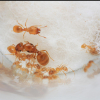I sent you some pics in a PM. No, I know what the problem is, I just haven't fixed it yet.
FIX it! FIX it! Fix it! Or send me the pics too! LOL ![]()
![]()

I sent you some pics in a PM. No, I know what the problem is, I just haven't fixed it yet.
FIX it! FIX it! Fix it! Or send me the pics too! LOL ![]()
![]()
Billy
Currently keeping:
Camponotus chromaiodes
Camponotus castaneus
Formica subsericea
You should consider Pheidole pilifera for your other queen. I just don't think that she is long enough to be Ph. morrisii. Here is a pic:
Hi there! I went on a 6 month or so hiatus, in part due, and in part cause of the death of my colonies.
However, I went back to the Sierras, and restarted my collection, which is now as follows:
Aphaenogaster uinta, Camponotus vicinus, Camponotus modoc, Formica cf. aserva, Formica cf. micropthalma, Formica cf. manni, Formica subpolita, Formica cf. subaenescens, Lasius americanus, Manica invidia, Pogonomyrmex salinus, Pogonomyrmex sp. 1, Solenopsis validiuscula, & Solenopsis sp. 3 (new Sierra variant).
You should consider Pheidole pilifera for your other queen. I just don't think that she is long enough to be Ph. morrisii. Here is a pic:
I found a dead Ph. pilifera. I was so mad
You should make an ID post for your Pheidole queen. Then you will get a definitive answer. Also, are there any areas near you with pure sand, or extremely sandy soil?
Hi there! I went on a 6 month or so hiatus, in part due, and in part cause of the death of my colonies.
However, I went back to the Sierras, and restarted my collection, which is now as follows:
Aphaenogaster uinta, Camponotus vicinus, Camponotus modoc, Formica cf. aserva, Formica cf. micropthalma, Formica cf. manni, Formica subpolita, Formica cf. subaenescens, Lasius americanus, Manica invidia, Pogonomyrmex salinus, Pogonomyrmex sp. 1, Solenopsis validiuscula, & Solenopsis sp. 3 (new Sierra variant).
You should make an ID post for your Pheidole queen. Then you will get a definitive answer. Also, are there any areas near you with pure sand, or extremely sandy soil?
If it's in the dirt it wouldn't be colobopsis, colobopsis are strictly arboreal, with one species only nesting in white ash trees and the other is less picky with trees types.Today I was looking around outside, watching some colonies of Pheidole morrisii when I noticed a very inconspicuous hole in the dirt. Upon closer examination, it appeared to have an ant blocking the entrance, and I immediately wondered if this was Colobopsis. Since. The thing at the entrance has retreated a few millimeters down and I am not able to get a good look at it. That would be cool if it was, because I’ve not yet discovered a wild colony of this genus.
If it's in the dirt it wouldn't be colobopsis, colobopsis are strictly arboreal, with one species only nesting in white ash trees and the other is less picky with trees types.Today I was looking around outside, watching some colonies of Pheidole morrisii when I noticed a very inconspicuous hole in the dirt. Upon closer examination, it appeared to have an ant blocking the entrance, and I immediately wondered if this was Colobopsis. Since. The thing at the entrance has retreated a few millimeters down and I am not able to get a good look at it. That would be cool if it was, because I’ve not yet discovered a wild colony of this genus.
Sent from my Pixel XL using Tapatalk
It might have been a Pheidole major, they do that sometimes.
Hi there! I went on a 6 month or so hiatus, in part due, and in part cause of the death of my colonies.
However, I went back to the Sierras, and restarted my collection, which is now as follows:
Aphaenogaster uinta, Camponotus vicinus, Camponotus modoc, Formica cf. aserva, Formica cf. micropthalma, Formica cf. manni, Formica subpolita, Formica cf. subaenescens, Lasius americanus, Manica invidia, Pogonomyrmex salinus, Pogonomyrmex sp. 1, Solenopsis validiuscula, & Solenopsis sp. 3 (new Sierra variant).
Do they only eat springtails?
No, they will eat lots of other soft bodied small animals, but that is the food which is the easiest to provide for them.
0 members, 1 guests, 0 anonymous users